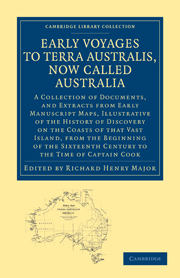 Early Voyages to Terra Australis, Now Called Australia
Early Voyages to Terra Australis, Now Called Australia Published online by Cambridge University Press: 05 February 2013
The Directors of the East India Company, encouraged by the successful return of the five ships of General Carpenter, richly laden, caused eleven vessels to be equipped the very same year, 1628, for the same voyage: amongst which, there was one ship called the Batavia, commanded by Captain Francis Pelsart. He sailed from the Texel on the 28th of October 1628; and, as it would be tedious to the reader to give him a long account of a passage so well known as that to the Cape of Good Hope, I shall pass over in silence that portion of his journal, and content myself with observing, that on the 4th of June in the following year, 1629, this vessel, the Batavia, being separated from the fleet in a storm, was driven on some rocks which lie in the latitude of 28° south, and which are called by the Dutch the Abrolhos of Frederick Houtman. Captain Pelsart, who was sick in bed when this accident happened, perceived at once that his ship had struck. It was night, indeed; but the moon shone very brightly, and the weather was fair. He immediately ran upon deck, and found that all the sails were set; their course was north-east by north; and the sea appeared covered with a white froth as far as the eye could reach.
To save this book to your Kindle, first ensure [email protected] is added to your Approved Personal Document E-mail List under your Personal Document Settings on the Manage Your Content and Devices page of your Amazon account. Then enter the ‘name’ part of your Kindle email address below. Find out more about saving to your Kindle.
Note you can select to save to either the @free.kindle.com or @kindle.com variations. ‘@free.kindle.com’ emails are free but can only be saved to your device when it is connected to wi-fi. ‘@kindle.com’ emails can be delivered even when you are not connected to wi-fi, but note that service fees apply.
Find out more about the Kindle Personal Document Service.
To save content items to your account, please confirm that you agree to abide by our usage policies. If this is the first time you use this feature, you will be asked to authorise Cambridge Core to connect with your account. Find out more about saving content to Dropbox.
To save content items to your account, please confirm that you agree to abide by our usage policies. If this is the first time you use this feature, you will be asked to authorise Cambridge Core to connect with your account. Find out more about saving content to Google Drive.